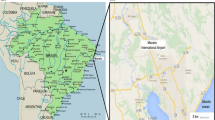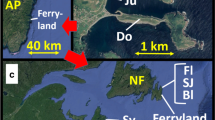Abstract
Fogs observed over Incheon international airport (IIA) in the west coast of Korea from January 2002 to August 2006 are classified into categories of coastal fog, cold sea fog, and warm sea fog based on the areal extent of the fogs and the difference between the air temperature (T) and the SST, i.e., cold sea fog if TSST = T−SST > 0°C and warm sea fog if TSST < 0°C. The numbers of coastal, cold, and warm sea fog cases are 64, 26, and 9. Coastal fogs form most frequently in winter, while cold sea fogs occur mostly in summer and warm sea fogs are observed from January to May but not in November and December. On average the air gets colder by 1.6°C during the three hours leading up to the coastal fog formation, and an additional cooling of 1.1°C occurs during the fog. The change in the dew point temperature (T d) is minimal except during the fog (0.6°C). Decreases in T for the cold and warm sea fogs are relatively smaller. The average T d is higher than SST during the cold sea fog periods but this T d is more than 4°C higher than that for the corresponding non-fog days, suggesting that cold sea fogs be formed by the cooling of already humid air (i.e., T d>SST). Increases of T d are significant during the warm sea fog periods (1.4°C), implying that efficient moisture supply is essential to warm sea fog formation. Four major synoptic patterns are identified in association with the observed fogs. The most frequent is a north Pacific high that accounts for 38% of cases. Surface or upper inversions are present in 77%, 69%, and 81% of the fog periods for coastal, cold, and warm sea fogs, respectively.
Similar content being viewed by others
References
Aguado, E., and J. Burt, 2004: Understanding Weather and Climate. 3rd ed., Prentice Hall, 560pp.
Bridger, A. F. C., W. C. Brick, and P. F. Lester, 1993: The structure of the marine inversion layer off the central California coast: Mesoscale conditions. Mon. Wea. Rev., 121, 335–351.
Cheong, S.-H., K.-Y. Byun, and T.-Y. Lee, 2006: Classification of snowfalls over the Korean Peninsula based on developing mechanism. Atmosphere, 16, 33–48. (in Korean with English abstract)
Cho, Y. K., M. O. Kim, and B. C. Kim, 2000: Sea fog around the Korean Peninsula. J. Appl. Meteor., 39, 2473–2479.
Choi, H., J.-W. Kim, and S. Takahashi, 1998: Three-dimensional numerical prediction of fog formation over coastal complex terrain. J. Korean Meteor. Soc., 34, 319–335.
Choi, H. and M. S. Speer, 2006: The influence of synopticmesoscale winds and sea surface temperature distribution on fog formation near the Korean western Peninsula. Meteorological Applications, 13, 347–360.
Croft, P. J., D. L. Darbe, and J. F. Garmon, 1995: Forecasting significant fog in southern Alabama. National Weather Digest, 19, 10–16.
Croft, P. J., R. L. Pfost, J. M. Medlin, and G. A. Johnson, 1997: Fog forecasting for the southern region: A conceptual model approach. Wea. Forecasting, 12, 545–556.
Filonczuk, M. K., D. R. Cayan, and L. G. Riddle, 1995: Variability of marine fog along the California coast. Scripps Institution of Oceanography Report 95-2, 102pp.
Fu, G., M. Zhang, Y. Duan, T. Zhang, and J. Wang, 2004: Characteristics of sea fog over the Yellow Sea and the East China Sea. Kaiyo Monthly, 38, 99–107.
Garmon, J. F., D. L. Darbe, and P. J. Croft, 1996: Forecasting significant fog on the Alabama coast: Impact climatology and forecast checklist development. NWS Technical Memorandum NWS SR-176, 16pp.
Gerber, H. E., 1981: Microstructure of a radiation fog. J. Atmos. Sci., 38, 454–458.
Gultepe, I. R., and Coauthors, 2007: Fog research: A review of past achievements and future perspectives. Pure and Applied Geophysics, 164, 1121–1159.
Han, Y.-H., and J.-S. Jeong, 1991: On the effect of sea surface temperature to temperature and humidity of western region of Korea. J. Korean Meteor. Soc., 27, 197–203. (in Korean with English abstract)
Heo, K.-Y., and K.-J. Ha, 2004: Classification of synoptic pattern associated with coastal fog around the Korean peninsula. J. Korean Meteor. Soc., 40, 541–556. (in Korean with English abstract)
Holets, S., and R. N. Swanson, 1981: High-inversion fog episodes in central California. J. Appl. Meteor., 20, 890–899.
Johnson, A., and J. J. O’brien, 1973: A study of an Oregon sea breeze event. J. Appl. Meteor., 12, 1267–1283.
Johnson, G. A., and J. Graschel, 1992: Sea fog and stratus: A major aviation and marine hazard in the northern gulf of Mexico. Symp. on Weather Forecasting, Atlanta, GA, Amer. Meteor. Soc., 55–60.
Klein, S. A., and D. L. Hartmann, 1993: The seasonal cycle of low stratiform clouds. J. Climate, 6, 1587–1606.
Koracin, D., J. Businger, C. Dorman, and J. Lewis, 2005: Formation, evolution, and dissipation of coastal sea fog. Bound.-Layer Meteor., 117, 447–478.
Koracin, D., J. Lewis, W. T. Thompson, C. E. Dorman, and J. A. Businger, 2001: Transition of stratus into fog along the California coast: Observations and modeling. J. Atmos. Sci., 58, 1714–1731.
Lamb, H., 1943: Haars or North Sea fogs on the coasts of Great Britain. Meteorology Office Publication M. O. 504, 24pp.
Lee, H.-Y., 2000: The Climate of Korea. Bobmunsa, 237pp. (in Korean)
Lee, S. H., 1995: The division of natural seasons in Korea by air pressure patterns in Korean Peninsula and its surroundings. Geographic Res., 26, 65–78. (in Korean with English abstract)
Leem, H. H., D. H. Kim, and K. W. Song, 2005a: The importance of fog prediction at the Incheon Int’l Airport through flight delay and cancel statistics. Journal of Korean Society for Aeronautial and Space Sciences, 13, 1–10. (in Korean with English abstract)
Leem, H. H., H. W. Lee, and S.-H. Lee, 2005b: The analysis of the characteristics of the fog generated at the Incheon int’l airport. Journal of the Korean Meteorological Society, 41, 1111–1123. (in Korean with English abstract)
Leipper, D. F., 1994: Fog on the U. S. West coast: A review. Bull. Amer. Meteor. Soc., 75, 229–240.
Leipper, D. F., 1995: Fog forecasting objectively in the California coastal area using LIBS. Wea. Forecasting, 10, 741–762.
Lewis, J., D. Koracin, R. Rabin, and J. Businger, 2003: Sea fog off the California coast: Viewed in the context of transient weather systems. J. Geophy. Res., 108(D15), 4457, doi: 10.1029/2002JD002833.
METRI, 2004: A study on the wind characteristics around Gangneung city. Meteorological Research Institute Final Report MR042A25, 84pp.
Meyer, M. B., and G. G. Lala, 1990: Climatological aspects of radiation fog occurrence at Albany, New York. J. Climate, 3, 577–586.
Noonkester, V. R., 1979: Coastal marine fog in southern California. Mon. Wea. Rev., 107, 830–851.
Park, S.-U., and C.-H. Joung, 1984: Air modification over the Yellow Sea during cold-air outbreaks in winter. J. Korean Meteor. Soc., 20, 35–50.
Pilie, R. J., E. J. Mack, C. W. Rogers, U. Katz, and W. C. Kocmond, 1979: The formation of marine fog and the development of fog-stratus systems along the California coast. J. Appl. Meteor., 18, 1275–1286.
Roach, W. T., 1995: Back to basics: Fog: Part 3-the formation and dissipation of sea fog. Weather, 50, 80–84.
Ryznar, E., 1977: Advection-radiation fog near Lake Michigan. Atmos. Environ., 11, 427–430.
Saunders, P. M., 1964: Sea smoke and steam fog. Quart. J. Roy. Meteor. Soc., 90, 156–165.
Sorli, B., F. Pascal-Delannoy, A. Giani, A. Foucaran, and A. Boyer, 2002: Fast humidity sensor for high range 80%–95% RH. Sensors and Actuators A: Physical, 100, 24–31.
Stull, R. B., 1988: An Introduction to Boundary Layer Meteorology. Kluwer Academic, 666pp.
Telford, J. W., and S. K. Chai, 1984: Inversions, and fog, stratus and cumulus formation in warm air over cooler water. Bound.-Layer Meteor., 29, 109–137.
Won, D. J., S.-Y. Kim, K.-E. Kim, and K.-D. Min, 2000: Analysis of meteorological and oceanographic characteristics on the sea fog over the Yellow Sea. J. Korean Meteor. Soc., 36, 631–642. (in Korean with English abstract)
Author information
Authors and Affiliations
Corresponding author
Rights and permissions
About this article
Cite this article
Kim, C.K., Yum, S.S. Local meteorological and synoptic characteristics of fogs formed over Incheon international airport in the west coast of Korea. Adv. Atmos. Sci. 27, 761–776 (2010). https://doi.org/10.1007/s00376-009-9090-7
Received:
Revised:
Published:
Issue Date:
DOI: https://doi.org/10.1007/s00376-009-9090-7




